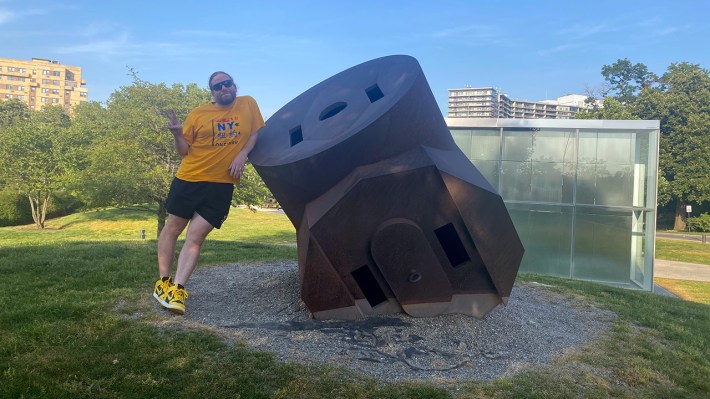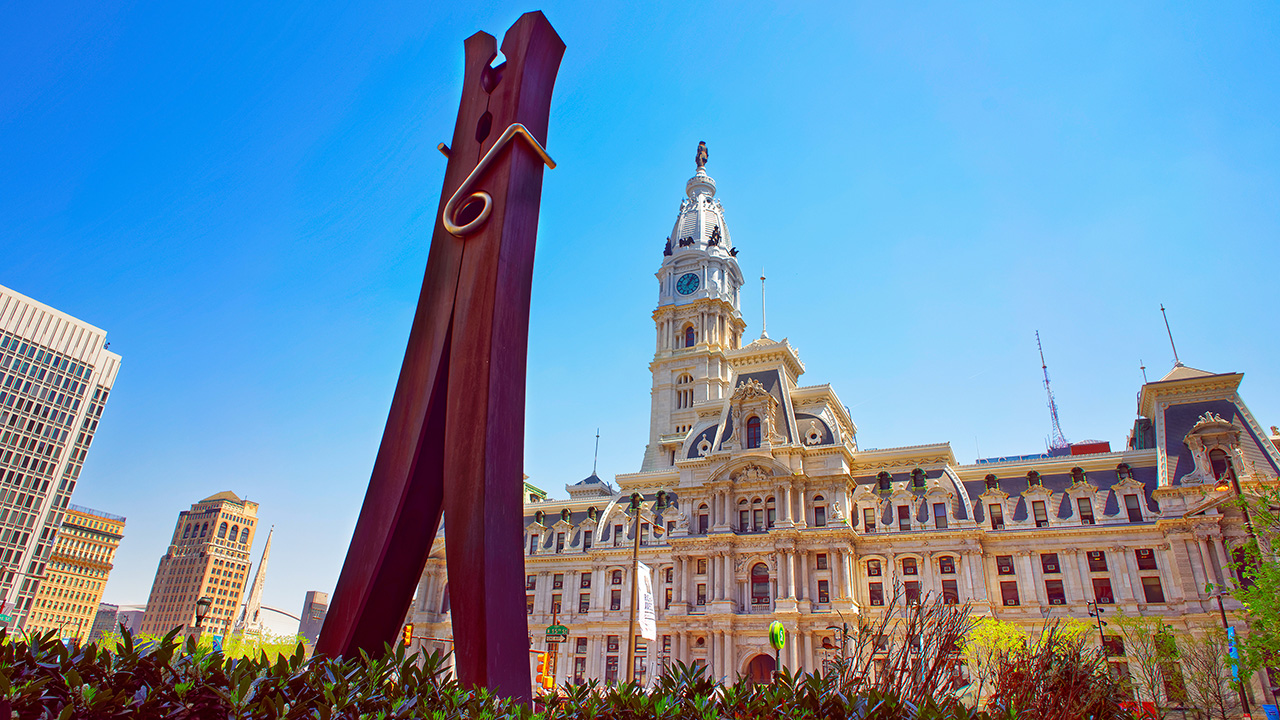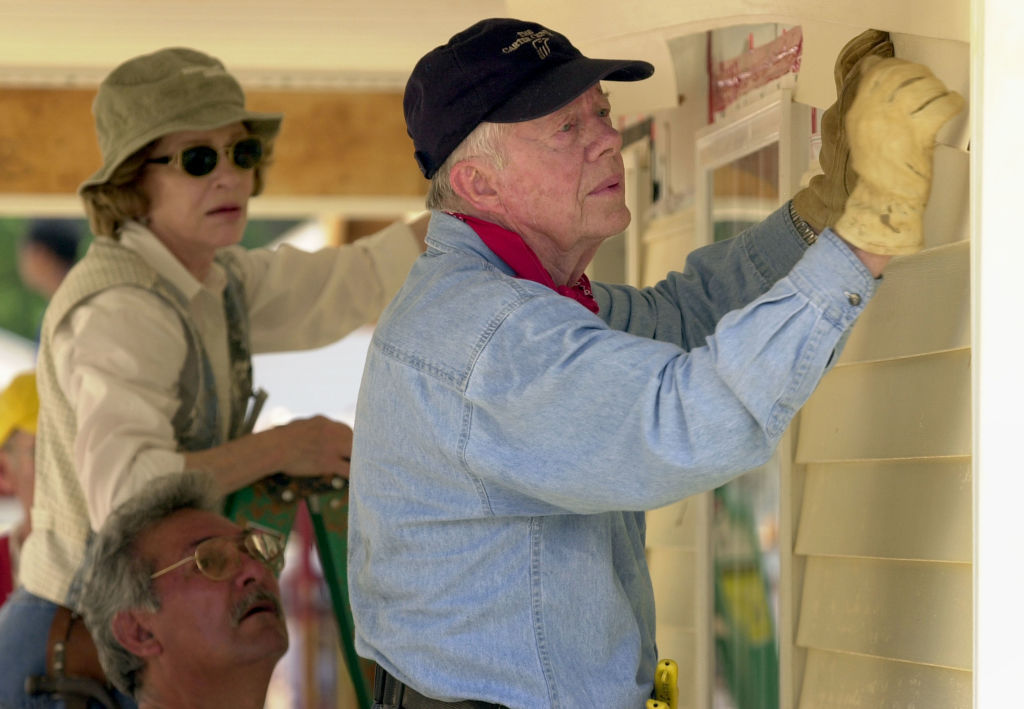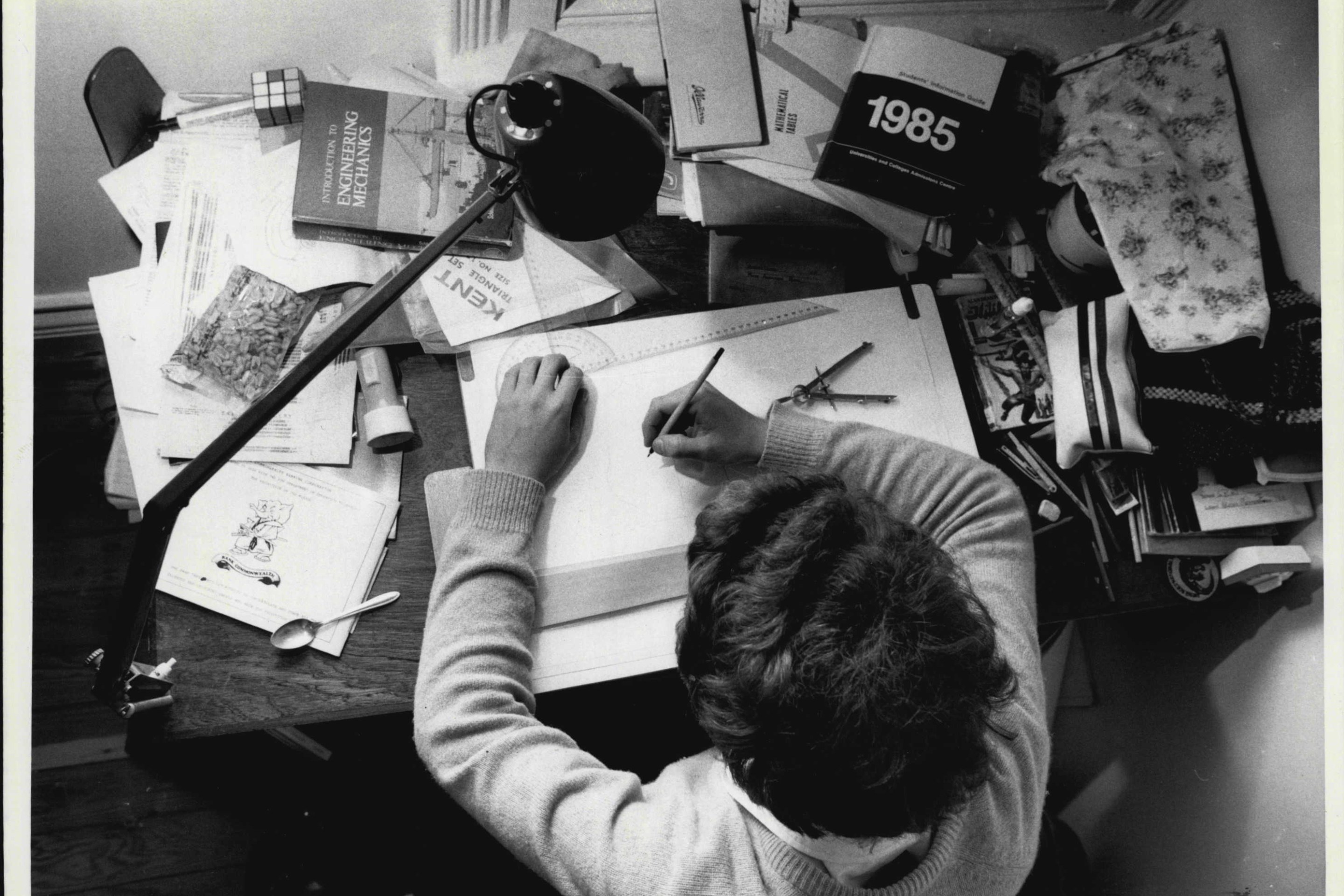The headline was blasted atop The Philadelphia Inquirer’s metro section on November 3, 1975: Here Comes 4-Story Clothespin. “A four-story high, almost Gothic-appearing clothespin, which the artist proclaims as an updated version of ‘The Kiss’,” art critic Victoria Donohue wrote, “is expected to become a new Philadelphia landmark within 18 months.”
It was to be one of just many art pieces constructed at the new Centre Square office complex, just across from City Hall. There was an art requirement, as it was being built on land purchased from the city. Developer Jack Wolgin, the former head of the city’s art commission himself, contacted artists great and small to fill the space. There was also supposed to also be a statue of a Philadelphia mummer, but that fell through, leaving Centre Square to purchase the Mummer-like Milord la Chamarre (My Lord of the Fancy Vest) by Jean Dubuffet.
The Fancy Vest Lord is still there, and so is Clothespin—a silly, simple giant sculpture by Claes Oldenburg, who died yesterday at 93. His Clothespin was the best piece of public art in Philadelphia. It might be my favorite public art anywhere.
Oldenburg was born in Sweden and worked in New York City. He began with representations of his Lower East Side neighborhood in the early 1960s, inspired by all the hustle and grime and charm of the neighborhood. Later in the decade he was doing hippie performance art: A work titled Placid Civic Monument featured gravediggers shoveling a 6-by-3-foot rectangular hole in the ground behind the Met. In 1969 he installed Lipstick (Ascending) on Caterpillar Tracks at Yale University, a giant lipstick tube which became a place for anti-war protests. A Yale alumni mag story says the whole thing “was kept secret from the Yale authorities.”
This was Oldenburg’s first major work, and just the sort of thing he’d become best known for. He called those giant versions of everyday objects “large scale projects.” There are so many! Pool balls and a pick-axe and a toothbrush, in Germany. Binoculars in Venice, California. A needle and thread in Italy. A “FREE” stamp outside the free library in Cleveland. A flashlight at UNLV. Many of his works, like Umbrella in Des Moines, Iowa, were done in collaboration with wife Coosje van Bruggen. They were married in 1977. She died in 2009.
There are several of Oldeburg's works in Philadelphia. His most recent work is Paint Torch, a giant paintbrush complete with a poop-emoji daub of paint. That one’s OK. One of my favorites is Giant Three-Way Plug, which is behind the Art Museum here and also at Oberlin College.

But Clothespin is the best. When it was installed, it was instantly divisive. In a defense of the project before it was built, the Inquirer’s Tony Auth wrote that “many were appalled.” Other staffers were even less enthused. “We need a symbol to show we’re not the snoozing mossbacks of the stereotype—to show that we’re what Macriarose would call ‘with-it’ or ‘today,’” Bob Lancaster wrote. “And the symbol we're going to get is a clothespin.” The day it was installed, the paper said it received mixed reviews. “What does it stand for,” construction worker Jerry Cannon said. “You think it has to do with being between two banks?”
Some people still hate it. By 1982 the Inquirer called it “the champion of controversy” in a story by future Black Hawk Down writer Mark Bowden. “You think of all the great things that have happened in this city, and somebody who, for some ungodly reason, wants to put up something like that that makes us a laughingstock to the rest of the world,” said Art Gorman, a man who led the successful push for the city to display the Rocky statue. “I mean, what kind of city do people think this is, with a giant clothespin in the middle of it? It's in poor taste, you know?”
I will not address what kind of city people think Philadelphia is, but I will allow that the big clothespin is maybe not as good a tourist attraction as a famous movie prop. Whatever. Clothespin is clearly the better public art. I first fell for it as a teenager, during my first years exploring Center City on my own. I am old enough that those years came before wide usage of cell phones, and so if friends came down separately we’d need a place to meet. We didn’t meet at the eagle, the department store sculpture that was also known as a meeting place. We met at the clothespin. It was bigger. It was newer. It is a better landmark than the eagle, which is a sculpture I still like so much I proposed to my wife in front of it.
It is important to emphasize how big this sculpture is. Clothespin is 45 feet tall. It is on a pedestal in the middle of the entrance to the underground section of Centre Square and the intersection of Philadelphia’s two subway lines. (Oldenburg said, if placed on the ground, it created a wind tunnel.) That height is important. This is a heavily-developed area, and the clothespin creates a friendly intermediary in scale between the tall buildings and the tiny people scurrying below. It makes the downtown landscape a less alienating space. If you’re wondering if I took that previous sentence from my friend with an art degree, I absolutely did.
There’s more, too. The pins on the Clothespin look like a “76,” an Important Philadelphia Number, and if you walk behind it the clothespin lines up perfectly with the City Hall tower. And, yes, it references The Kiss, a sculpture by Constantin Brâncuși. I kinda see it. My art school friend is a little more confident about this one than I am.
But you don’t even need all that explanation to like Clothespin. It’s a big clothespin in the center of downtown Philadelphia. What more do I need to tell you? It rules. Here’s to the man who built it.





